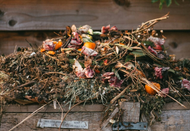Posted by Sally Shaw from Gubba Garden Store
29th Jul 2025
How to improve & prepare your soil for planting
Winter might feel like a sleepy time in the garden, but it’s actually the perfect season to focus on your soil. With the summer rush behind us, there’s time to slow down, take stock, and give your soil the love it needs to bounce into spring full of life.
In this guide, Sally Shaw from Gubba shares practical tips to help you understand your soil and boost its health with simple, natural inputs.
First things first: soil is not just dirt
“To be a successful farmer one must first know the nature of the soil.” – Xenophon, c. 430 BC
Soil is alive. It’s teeming with microbes, rich with organic matter, and absolutely central to how well your garden grows. Whether you’re chasing bigger veg, more blooms, or plants with fewer pest problems, it all starts below ground.
And the easiest way to improve your soil? Add organic matter.
Why organic matter matters
Adding organic matter (like compost, manure, or leaf litter) improves soil structure, feeds microbes, boosts moisture retention, and loads your garden up with nutrients. A healthy, thriving soil ecosystem means healthier plants—and fewer headaches for you.
A 5cm layer dug into the top few inches is a great start. If your soil is heavy clay or super sandy, you might need to do this a few times throughout the year.
What kind of soil do you have?
Understanding your soil’s structure helps you know what it needs. Most gardeners are aiming for something close to loam—a rich, crumbly mix of about 40% sand, 40% silt and 20% clay. Loam drains well, holds nutrients, and lets roots spread freely.
Here’s a quick way to test your soil at home:
-
Roll a moist (not wet) handful of soil into a ball and give it a squeeze.
-
Clay soil: sticky, holds its shape firmly
-
Sandy soil: gritty, falls apart easily
-
Silty soil: smooth, holds its shape but softer than clay
-
Loamy soil: holds its shape, crumbles easily
-
No matter your soil type, adding organic matter will help move it toward that ideal loamy texture.
A quick soil health test (worms to the rescue!)
Earthworms are great indicators of soil health. Dig a spadeful of soil (about 30cm x 30cm), place it on cardboard, and count the wrigglers.
-
10 or more worms = good soil health
-
Fewer than 10 = time to add more organic matter
Spring is ideal for this test, but you can do it anytime (as long as it hasn’t just rained).
DIY organic matter: compost, bokashi & worms
You can make rich, microbe-packed organic matter right at home with:
-
Compost: Mix “greens” (kitchen scraps, clippings, manure) with “browns” (leaves, cardboard, prunings). Mature compost is dark, crumbly, and smells earthy.
-
Bokashi: Great for small spaces, it ferments almost all kitchen waste (yes, even meat and dairy). You’ll need bokashi bran and two bins to rotate.
-
Worm farms: These little legends munch through food scraps and produce worm castings and “worm wee”—liquid gold for your garden.
Other ways to boost soil health
While organic matter is your best bet, here are a few extras worth trying:
-
Cover crops: Sow green manures in the off-season to add nutrients and improve soil structure.
-
Crop rotation: Helps reduce pests and disease while balancing soil nutrients.
-
Mulching: Retains moisture, regulates soil temp, and breaks down into more organic matter over time.
-
Natural fertilisers: Fish emulsion, bone meal, and blood meal are all excellent additions without the downsides of synthetic fertilisers.
Improving clay soils
Clay soils can be tough—but not impossible. Break them up with regular applications of compost, aged manure, or gypsum. Over time, you’ll notice better drainage, looser soil, and happier plants.
Getting to know your soil pH
Soil pH affects how easily plants can absorb nutrients. Most garden plants prefer a slightly acidic soil—around 6 to 6.5.
You can buy a pH test kit, or try this DIY version:
You’ll need:
-
2 bowls
-
1 cup of soil
-
½ cup water
-
½ cup baking soda
-
½ cup vinegar
What to do:
-
Add 2 tablespoons of soil to each bowl.
-
In one bowl, add water and vinegar. If it fizzes, your soil is alkaline.
-
In the other, add water and baking soda. If it fizzes, your soil is acidic.
-
No fizz? You’re sitting pretty with neutral soil.
Raised garden beds to the rescue
If your native soil is just not cutting it, raised beds give you full control. Fill them with a rich blend of compost, topsoil and aged manure, and you’ll have perfect planting conditions from day one. Raised beds also improve drainage and warm up faster in spring.
The takeaway
Healthy soil is the secret to a great garden. Whether you're reviving tired beds or building a new patch from scratch, it all starts with organic matter.
Keep adding compost. Test your pH. Check for worms. And most importantly—give it time. Good soil doesn’t happen overnight, but if you feed it well and let the microbes do their thing, your plants will thank you in every season to come.


























